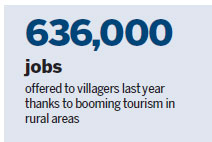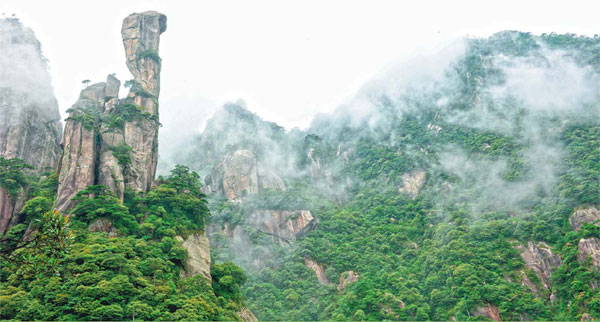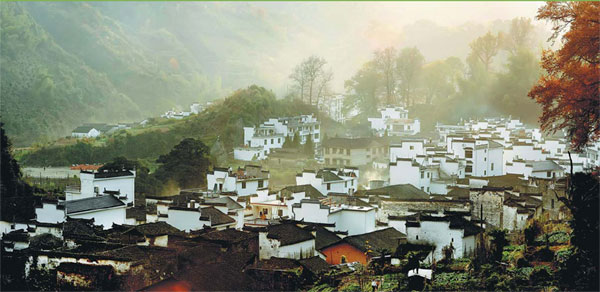Jiangxi's ecological civilization program drives rural incomes
The province has been designated a pilot zone for recovering natural landscapes and innovative regulation models, Li You reports.
In recent years, Jiangxi province has made marked progress regarding new practices and reforms to preserve its environment.
The central government released an implementation plan for national ecological civilization pilot zones in Jiangxi in October.
The plan designated Jiangxi as a sample province for recovering the ecology of mountains, rivers, forests, farmland and plants, as well as a pilot zone in innovating ecological preservation regulation and rural tourism.
In 1983, Jiangxi launched the Mountain-River-Lake Program with a large-scale examination of Poyang Lake, the largest natural freshwater lake in China.
More than 600 experts from 14 countries walked along the mountains and rivers, before finally providing the "recipe" for ecologic preservation. They advised considering the regions around the Gannan mountains, Ganjiang River and Poyang Lake as an entire ecosystem and pursuing their all-round preservation.

The program laid the foundation for Jiangxi's overall environmental recovery and was regarded as a pioneer project in protecting the ecosystems of large river basins.
In 2003, the provincial government began to promote green development across the whole province and made great efforts to shut down any remaining projects that caused heavy pollution. In 2009, the State Council approved the Planning of Poyang Lake Ecological Economic Zone, meaning protecting the zone has become a national development strategy.
In 2014, Jiangxi was nominated as one of the five demonstration zones in China by six governmental ministries, including the National Development and Reform Commission.
In August 2016, the central government released the Guideline of the Construction of National Ecological Experimental Zones, selecting Fujian, Jiangxi and Guizhou provinces as the first batch of experimental zones.
The targeted means of improving the environment has proven effective over the years.
According to the guideline, Jiangxi will establish an ecological compensation mechanism to provide a consistent example from which other provinces can learn.
Jiangxi has set a target that forest coverage should be maintained at 63 percent by the end of 2020. The proportion of surface water with excellent or good quality should be increased to 85.3 percent.
The region's high-quality environment is obvious from its surging tourism industry, evidenced over the past national holiday.
Some 60 million tourists visited the province in the first week of October, generating a total of 36.86 billion yuan ($5.57 billion) in revenue, according to local officials. The officials attribute the accomplishment to the continuous effort made in environmental recovery in the past 30 years.
Adhering to the guideline of innovative, coordinated, green, open and shared development models, Jiangxi emphasizes green development most of all, according to officials.
From the Mountain-River-Lake Program to the construction of national ecological experimental zones, Jiangxi continues to pursue balanced preservation of the ecosystem and local development.
In 2016, Jiangxi established an ecological compensation mechanism for major river basins across the whole province.
After an array of preservation measures, the proportion of surface water with excellent or good water quality was maintained at 80 percent. One hundred percent of the drinking water in the whole province has been proven to meet the national standard.
According to the Jiangxi Development and Reform Commission, the implementation plans for national ecological civilization pilot zones released in October comprise 42 key construction missions and 38 innovative reforms.
In the coming years, the province will initiate an evaluation system based on the performance of ecological construction. The system has been completed and it is scheduled to be implemented next year.
By that time, the province will cease GDP assessments as the basis for measuring performance, and instead will give a higher weighting to issues related to ecology construction and poverty alleviation.
Jiangxi is home to 110 rural tourism sites ranked 4A or above. In recent years, the industry has been regarded as an important source of income for villagers.
But rural tourism is about more than just eating and living in village houses. It requires a wide range of resources, including infrastructure.
In October, Jiangxi issued implementation plans for developing rural tourism, aiming to boost and upgrade local infrastructure.
To encourage public investment in construction, the local government initiated an innovative investment model and let private capital participate in the construction and operation of infrastructure, such as washing rooms, sewage disposal plants and parking spaces.
To give full play to Jiangxi's advantages, the province is constructing three to five major tourism sites that visitors can drive to by themselves.
By the end of 2020, the number of self-driving sites is expected to reach 30.
In 2016, Jiangxi villages received 263 million visits, an increase of 38.53 percent year-on-year.
The number of visitors traveling to villages is roughly half of the province's total number of visitors.
Rural tourism generated more than 232.65 billion yuan in annual revenue in 2016, accounting for nearly 47 percent of the province's total tourism revenue.
Booming tourism in rural areas also generated jobs for 636,000 villagers last year, lifting 150,000 people out of poverty.
In 2017, the province will focus on building more than two 5A level tourist villages, 10 stylish tourism towns, 20 provincial-level beautiful leisure villages, 50 high-quality farmhouses and 10 village-visiting routes, according to local officials.
The province will strive to realize 440 million rural tourism visits by 2020, they said.
The total tourism revenue in rural areas will be more than 500 billion yuan, which is expected to benefit more than 1.8 million people.
Contact the writer at liyou@chinadaily.com.cn


(China Daily 11/10/2017 page18)














